Jay Zeamer & Joe Sarnoski
Jay Zeamer & Joe Sarnoski
1 Plane – 9 Heroes – 2 Medals of Honor
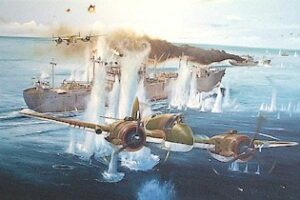 While General Ira Eaker’s Mighty Eighth (Air Force) was making history in Europe, General George Kenney’s new Fifth Air Force was building a reputation of its own. This was the unit that had been in such disarray in the spring of 1942 that General MacArthur had fired the air chief and demanded an immediate replacement, prompting Kenney’s transfer to Australia. Upon Kenney’s arrival, MacArthur quickly voiced his lack of confidence in his air arm or its abilities–even indicating that he distrusted the airmen’s loyalty to his leadership.
While General Ira Eaker’s Mighty Eighth (Air Force) was making history in Europe, General George Kenney’s new Fifth Air Force was building a reputation of its own. This was the unit that had been in such disarray in the spring of 1942 that General MacArthur had fired the air chief and demanded an immediate replacement, prompting Kenney’s transfer to Australia. Upon Kenney’s arrival, MacArthur quickly voiced his lack of confidence in his air arm or its abilities–even indicating that he distrusted the airmen’s loyalty to his leadership.
With the help of men like Generals Kenneth Walker and Enis Whitehead, the Fifth Air Force quickly began to give a good account of itself, netting two Medals of Honor in six months to air heroes Captain Harl Pease and General Ken Walker. Two days after General Walker was lost on a mission over Rabaul, another of General Kenney’s young pilots became an ace. That man was Richard Ira Bong, the stunt-flying kid whose aerial antics had got him noticed, and reprimanded before Kenney left California. (Kenney insisted on taking Bong with him when he took command of the air force in Australia.)
By the end of 1942, despite a shortage of aircraft and replacement parts, the rag-tag men of the Fifth Air Force had gained air superiority in the region and ingratiated themselves to MacArthur. Though top military commanders back in the United States had ordered the Pacific Forces to wage only a containment action while the war in Europe took first priority, it seemed no one in the Fifth Air Force realized that they were not supposed to defeat the Japanese until the war in Europe had been won. Through sheer guts and determination, these men ended the Japanese offensive in the South Pacific by late 1942 and forced the enemy to go on the defensive.
Ken’s Men, as the pilots and crews of the Fifth Air Force came to call themselves, were an interesting bunch. Captain Harl Pease, who earned the Medal of Honor after patching up an un-flyable B-17 and piloting it from Australia to Rabaul. General Kenneth Newton Walker, who defied orders from General Kenney that forbade him from flying combat missions, and was subsequently lost in action on a daring raid over the Japanese-held harbor.
 While Fifth Air Force pilots and ground crews were proud to be called Ken’s Men, MacArthur’s staff had a different title for the daring but unconventional airmen. Shortly after George Kenney’s arrival and introduction to the top General in the Pacific, MacArthur had told him, “George, you were born three hundred years too late. You’re just a natural-born buccaneer.” When the Supreme Commander’s staff referred to the men of the Fifth Air Force as Buccaneers, they sometimes didn’t mean it with the same respect MacArthur had implied. But that was okay with Ken’s Men, they weren’t concerned with titles, they were occupied getting the job done.
While Fifth Air Force pilots and ground crews were proud to be called Ken’s Men, MacArthur’s staff had a different title for the daring but unconventional airmen. Shortly after George Kenney’s arrival and introduction to the top General in the Pacific, MacArthur had told him, “George, you were born three hundred years too late. You’re just a natural-born buccaneer.” When the Supreme Commander’s staff referred to the men of the Fifth Air Force as Buccaneers, they sometimes didn’t mean it with the same respect MacArthur had implied. But that was okay with Ken’s Men, they weren’t concerned with titles, they were occupied getting the job done.
Once, when several of Kenney’s fighter pilots were picked up in Sydney for disorderly conduct, MacArthur told his staff, “Leave Kenney’s kids alone. I don’t want to see them grow up either.”
Ken’s Men turned the tide of the Pacific air war through sheer guts, determination, and ingenuity. The ground crews worked night and day repairing aging and battered airplanes with flattened tin cans, cannibalizing the very worst of their air fleet for parts. When combat conditions demanded new tactics, they invented them. One such example was the development of skip bombing.
Much of the Fifth Air Force’s initial responsibility was to neutralize enemy shipping in the region, shipments that reinforced embattled Japanese troops at places like Guadalcanal and Lei. Regular missions were mounted against major harbors, as well as against ships on the high seas. American bombers did their best to sink them from high above, but with only limited success.
In August and September 1942 Major William Benn, who had come to Australia as General Kenney’s aide and then given command of the B-17s of 63rd Squadron, 43rd Bombardment Group, began practicing the new skip-bombing technique on a wrecked ship in the harbor at Port Moresby. Rather than releasing their bombs from high above the enemy ship, the plan was for Benn’s daring pilots to fly as low as 200 feet, aiming the nose of their bombers directly at enemy targets, and then releasing their bombs on a near horizontal trajectory to skip across the water into the ship’s side. Under combat conditions the pilots would be flying directly into the enemy guns at speeds over 200 miles per hour. The bombs were to be released from a distance of 300 yards or less, forcing the pilot to climb quickly to avoid a collision. The practice was dangerous and required concentration and nerves of steel.
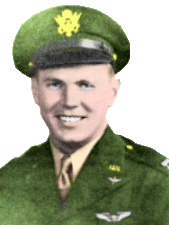 By October 23, 1942, Benn’s pilots were ready to try the concept on actual enemy targets. During a night raid over Rabaul, six Flying Fortresses dropped bombs on the enemy harbor from 10,000 feet, while six other B-17s came in at 100 feet to skip their bombs. Piloting the bomber named Black Jack, Captain Ken McCullar sank a destroyer with two hits amidships.
By October 23, 1942, Benn’s pilots were ready to try the concept on actual enemy targets. During a night raid over Rabaul, six Flying Fortresses dropped bombs on the enemy harbor from 10,000 feet, while six other B-17s came in at 100 feet to skip their bombs. Piloting the bomber named Black Jack, Captain Ken McCullar sank a destroyer with two hits amidships.
McCullar was quickly becoming a legend in the Southwest Pacific. Before October 23 he had sunk or damaged four enemy ships. The adaptation to skip-bombing only improved his record, and on the second skip-bombing mission two nights later Captain McCullar was one of four pilots, out of six bombers, to score a direct hit on the enemy.
During those late-October missions Captain McCullar flew into Rabaul three times with a particular good friend in the navigator’s chair once, and then in the copilot’s seat twice. That friend was the most likeable man in the 43rd Bombardment Group, an officer who was generally popular everywhere except in the cockpit.
Until the missions with McCullar no one had wanted to fly with Lieutenant Zeamer. For this reason, he had no assigned airplane or crew. Instead, he roved the entire group as a “pilot-at-large”. To make matters more complicated, Jay Zeamer he wasn’t actually even a pilot.
He was, in fact, the most senior non-pilot, pilot in the entire Group.
Jay Zeamer
 Born in Carlisle, Pennsylvania, Jay Zeamer and their family later moved to Orange, New Jersey. In his youth, on those rare occasions when his traveling-salesman father was home, the family vacationed in Boothbay Harbor, Maine. Jay’s affinity for the rural area of Maine would have a lifetime impact.
Born in Carlisle, Pennsylvania, Jay Zeamer and their family later moved to Orange, New Jersey. In his youth, on those rare occasions when his traveling-salesman father was home, the family vacationed in Boothbay Harbor, Maine. Jay’s affinity for the rural area of Maine would have a lifetime impact.
Jay loved scouting, becoming an Eagle Scout at the age of thirteen–to the detriment of his school studies. To improve his son’s education, his father enrolled him in Indiana’s Culver Military Academy when he was fourteen. The experience fed the young man’s interest in the military. A few years later while attending Massachusetts Institute of Technology (MIT) after graduating high school, Jay became an ROTC cadet in the Army Corps of Engineers, despite the fact that his developing interest was in aviation. To satisfy the latter he joined a flying club and took lessons in nearby Norwood. In 1939, while still at MIT, Jay has commissioned a second lieutenant in the Infantry Reserve. Following graduation in 1940 with a bachelor’s degree in civil engineering, he was assigned to Fort Dix, NJ.
There Jay was discharged to enlist in the Regular Army as a flying cadet and completed primary flight school at Glenview, Illinois, where his leadership skills earned him the position of Captain of Cadets. In March 1941 he received his wings after graduating from advanced flight school at Maxwell Field, Alabama. On March 14 he entered active duty with the U.S. Army Air Corps, sacrificing two years’ time in rank to realize his dream of becoming a pilot.
That summer he flew as copilot during service testing of new B-26 Martin Marauders, following which he was assigned to the 19th Bombardment Squadron, 22nd Bombardment Group at Langley Field. There all of Jay’s classmates checked out as pilots and were assigned aircraft and crews. Jay just couldn’t seem to get it right, couldn’t find a way to pass the check. As a result, he remained frozen in the co-pilot’s seat. Jay’s close friend and fellow pilot Lieutenant Walt Krell recalled:
“Jay Zeamer as a pilot had the kind of very relaxed attitude that I liked. When you got right down to it, he was the most relaxed man in an airplane I ever knew. Nothing ever seemed to bother him. No emergency could shake him. He was the kind of guy that everyone took to.
“For some reason, Jay just couldn’t hack it (the flight check). Every one of us tried to check him out. We figured that someone, somewhere along the line, would find the monkey that was riding Jay’s back. But whatever it was we couldn’t find it. Jay was stuck in the right seat as a copilot.
“We kept trying, of course. You just had to do your best to get him into the left seat, where everyone felt he belonged. But we just couldn’t turn him loose because…well, the way he’d come into the field would turn your hair white. We’d go out and shoot landings, and slow the airplane down to about 130 and you’d hear, you would feel it get washy, soft and mushy on the controls; you’d grab it and put in on the ground and turn back to Zeamer and then you’d say:
‘Jay, you know what you did wrong that time?’
“He not only didn’t know what he had done–he didn’t even know that anything was wrong!”
On the day after the Pearl Harbor attack, the 22nd was transferred from Langley to California to fly submarine patrols off the west coast. Still stuck in the copilot’s seat, Zeamer was bored and unhappy through the endless hours of droning over the empty Pacific. Little changed when the B-26s were sent to Australia in March 1942 to confront and fight the Japanese.
Jay was a good pilot, skillful and daring, but for some reason, he just never did manage to get past the check flight in the Marauders. His frustration gave way to complacency…there was little for the copilot to do. On an early mission over Lei, Lieutenant Krell was keeping close tabs on one of his new pilots, an officer named Lieutenant Seffern who was making his first bombing mission. Lieutenant Jay Zeamer was in the copilot’s seat. Seffern did not do well when the bombers reached Lei, and upon landing back at Seven Mile Lieutenant Krell immediately began chewing the rookie out, demanding to know what had gone wrong.
“I’ll tell you what the hell was wrong!” Seffern shouted back. “You gave me Zeamer for a copilot, damn you!”
“What’s wrong with that?” Krell demanded.
“Wrong? I’ll tell you. When you gave me the signal to get ready for the bomb run, I woke Zeamer up and….”
Zeamer’s inability to get his own plane and his seemingly permanent relegation to the role of copilot had left him with no motivation. When enemy flak and Japanese fighters turned on the incoming bombers over Lei, Zeamer had awakened long enough to put on his Mae West and World War I helmet and then went back to sleep. He was so unnerved by the explosions around him, Krell noted, “All the way through the flak and bombing run he’s been asleep. I belted him on the chest to wake him up and hollered at him some more. Walt, he was sound asleep all over again.”
When Lieutenant Krell confronted Zeamer about this incident Jay responded, “I’m getting out of this outfit. I’ll never get anywhere here; hell, they won’t even let me be a cook.”
That ended Lieutenant Zeamer’s days in a B-26. Commanding Officer Colonel Dwight Divine managed to get him transferred out to the 43rd Bombardment Group. It would be Lieutenant Zeamer’s introduction to an airplane he could not only love…but master…the B-17 Flying Fortress.
The Battle for the Air
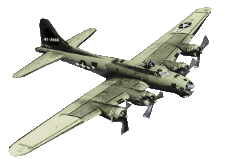 On September 14 the 43rd Bombardment Group moved to Port Moresby on the southern coast of New Guinea. In those early days, the fate of New Guinea was still very much in doubt. Japanese airplanes made daily flights out of Lae’s other airfields in the jungle, dropping down over the Owen Stanley Range to bomb and strafe the aerodromes at Port Moresby. Meanwhile, enemy ground forces were negotiating the Kokoda Trail and moving close to capturing Port Moresby. If that last Allied position in New Guinea fell, Australia would be in grave danger.
On September 14 the 43rd Bombardment Group moved to Port Moresby on the southern coast of New Guinea. In those early days, the fate of New Guinea was still very much in doubt. Japanese airplanes made daily flights out of Lae’s other airfields in the jungle, dropping down over the Owen Stanley Range to bomb and strafe the aerodromes at Port Moresby. Meanwhile, enemy ground forces were negotiating the Kokoda Trail and moving close to capturing Port Moresby. If that last Allied position in New Guinea fell, Australia would be in grave danger.
On September 15 Kenney’s cargo pilots conducted the first airlift in history, flying reinforcements from the Army’s 32nd Infantry Division to New Guinea. (Only one regiment was actually flown in, with the remainder transported from Australia by ship.) Within two weeks the Japanese ground forces were thrown back and, for the first time, it was the Allied forces that were on the offensive. Pilots of the 43rd Bombardment Group began flying regular missions to destroy aircraft on the ground at Lae using para frag bombs (small bombs dropped by parachute that exploded into thousands of small pieces of shrapnel to shred enemy fighters.)
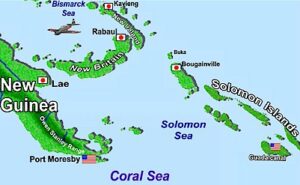 While Lei was a thorn in the flesh of the Allied war effort, the key to the enemy activity in the region was the great seaport at Rabaul on the north side of New Britain Island. Rabaul was to the Japanese, what Pearl Harbor was to the Americans–the key staging area for all activity in the Pacific. Supply ships from Japan steamed endlessly into Rabaul. From there, men and material were quickly dispersed down through the Solomon Islands, where US Marines were fighting for control of Guadalcanal. The nightly Japanese supply runs became known to them as The Tokyo Express.
While Lei was a thorn in the flesh of the Allied war effort, the key to the enemy activity in the region was the great seaport at Rabaul on the north side of New Britain Island. Rabaul was to the Japanese, what Pearl Harbor was to the Americans–the key staging area for all activity in the Pacific. Supply ships from Japan steamed endlessly into Rabaul. From there, men and material were quickly dispersed down through the Solomon Islands, where US Marines were fighting for control of Guadalcanal. The nightly Japanese supply runs became known to them as The Tokyo Express.
Rabaul also provided a steady stream of reinforcements to Lae, as well as to scores of enemy air bases scattered throughout the many islands that dotted the region. As such, Rabaul and its sister port further north at Kavieng became regular targets for Allied bombers. It was in missions against these that men like Harl Pease, Ken Walker, Ken McCullar, and others built their legends.
For Jay Zeamer there was little opportunity to join them in this effort. His reputation had preceded him in transfer, and when the 43rd moved to New Guinea Jay was left behind in Australia. He became a catch-all, the man was given the odd jobs. If he managed to find a crew that was short a man for a particular mission, he filled in, but never as a pilot. Jay Zeamer had never checked out on the B-17 either.
Jay’s problems in the cockpit aside, everyone loved the lanky guy with a big grin and a friendly manner. His friendship with Ken McCullar paid off not only in providing Zeamer the opportunity to fly B-17 missions as both a navigator and copilot late in October but with the chance to learn from one of the best. The innovative Captain McCullar went so far as to have his ground crews mount a 50-caliber machine gun in the nose of Black Jack, extra armament that could be fired from the cockpit. It was a practice not lost on Zeamer who, when at last he got his own airplane, planned to do the same and become one of the first pilots to use a heavy bomber as a fighter aircraft.
On Zeamer’s last mission with McCullar, their bomber was attacked by five Japanese Mitsubishi Zeroes. In the running battle that followed Lieutenant Zeamer studied McCullar, his coolness in the cockpit, and the evasive tactics that allowed him to bring his bomber home despite heavy damage from the fighters as well as from antiaircraft fire. For Zeamer that mission became something of a graduation ceremony. He was now ready to pilot his own B-17.
Lieutenant Zeamer’s status as a roving jack-of-all-trades placed him as an aide to the Intelligence Section at Port Moresby early in November. It was a busy time and a critical one for the Allied offensive at Guadalcanal. There had been major battles on that island throughout October. Early in November, Allied Intelligence received indications that the Japanese were mounting a major convoy at Rabaul to reinforce their troops at Guadalcanal.
What was needed were photographs of the buildup in Simpson Harbor so that effective strikes could be mounted against any such convoy. For three consecutive days reconnaissance missions were flown unsuccessfully, due to heavy cloud cover. On the fourth day, the pilot who was scheduled to make yet another attempt was grounded. Lieutenant Zeamer volunteered to fly the mission, despite the fact that he had still not checked out in the pilot’s seat of a B-17. By this time, no one seemed to care about that fact, and soon Zeamer was flying north in the left seat of a Flying Fortress.
The weather had not improved and the mission once again appeared doomed when the Flying Fortress arrived over Rabaul. The island was invisible, masked by heavy cloud cover. Then, in the distance, Zeamer noted that he could clearly see Kavieng at the north end of the distant island of New Ireland. The break in the weather pattern seemed strange until Zeamer recalled the active volcano to the west of Rabaul Harbor. (Many American bomber pilots claimed they could find the harbor in the dark just by the smell of sulfur emitted by that volcano.)
Quickly Zeamer’s keen mind solved the mystery–the volcano was constantly sending up a stream of hot air. This would undoubtedly clear the air beneath the clouds and, if one came in low enough, he should be able to get the needed recon photos.
Zeamer flew north to Kavieng and then plotted his course back to Rabaul. As he approached Simpson Harbor, he dropped down to 8,000 feet and his Fortress broke through the clouds and into clear airspace. Above him sixteen Mitsubishi fighters circled while Zeamer’s camera clicked away, capturing the scene below. What the camera revealed was at least 110 enemy ships, all of them firing back at the invading American bomber.
Zeamer’s crew fought back furiously while the pilot held his airplane on course until the photos had been taken, and then began a series of evasive “S” turns. As he finished the run, he was attacked by three Zeroes, all of which went down in flames, thanks to the accuracy of Zeamer’s gunners. Lieutenant Zeamer and his adopted crew finally accomplished what no other pilot in four days had been able to do. For his heroism and determination, Lieutenant Zeamer was awarded the Silver Star. So too, were all the other members of his crew on that mission.
Lieutenant Zeamer flew again and again thereafter, often in the pilot’s seat, despite the fact that he was still not checked out as a B-17 pilot. For whatever reason, his commanders chose to overlook that technicality. On a mission over Rabaul Harbor on January 16, 1943, Zeamer sank an 8,000-ton ship. For that action, he was awarded the Air Medal.
That same month his roving role put him temporarily in the 65th Bombardment Squadron as an operations officer. There he met Captain Rocky Stone, a navigator whose pilot had been reported missing in action. Stone and his bombardier asked Zeamer to fly with them and Zeamer quickly agreed. He respected both men for their courage and skill. The bombardier was a man he had met at Langley before the war, a young officer who was one of the best bombardiers in the Pacific.
Joseph Raymond Sarnoski
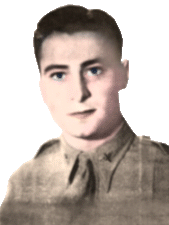 Three years Jay’s senior, Joe Sarnoski was the second-oldest child in a family of seventeen children belonging to a Polish coal miner in Zeamer’s home state of Pennsylvania. As the family had grown, Joe’s father’s health began to fail and he left the coal mines to begin farming. It was tough, but a suitable calling, for so large a family. All of the children worked hard to keep the farm operating and make ends meet.
Three years Jay’s senior, Joe Sarnoski was the second-oldest child in a family of seventeen children belonging to a Polish coal miner in Zeamer’s home state of Pennsylvania. As the family had grown, Joe’s father’s health began to fail and he left the coal mines to begin farming. It was tough, but a suitable calling, for so large a family. All of the children worked hard to keep the farm operating and make ends meet.
Though the rural farm life was tough and demanding, education was first priority in the Sarnoski family, and Joe received his first six grades of learning at Grade School #4 in nearby Fell Township. A few years later when his family moved to White’s Crossing, Joe completed his education there.
Though the responsibility of alternating between education and farm work left little free time, young Joe Sarnoski found diversion in numerous hobbies that included baseball, fishing, hunting, playing the accordion, and singing. In later years when he served as a bombardier in an American bomber, those who flew with him often recalled the sound of his voice belting out tunes over the interphones.
Joe’s biggest interest, however, was in aviation. He covered his walls with pictures of airplanes, built models, and read all he could about gliders and motorized aircraft. He constantly begged his parents to allow him to go somewhere where he could learn more about airplanes. On March 7, 1936, two months after his twenty-first birthday, Joe Sarnoski enlisted in the U. S. Army as an air cadet, entering service in Baltimore, MD.
Most of Joe’s duty was performed at Langley Field, Virginia, though he did spend considerable time training at Lowry Field in Colorado. He completed Lowry’s Advanced Aircraft Armorer’s Course in 1939. The following year he was discharged from the Regular Army to reenlist in the Army Air Corps, and then went on to complete Lowry’s Bombsight Maintenance Course early in 1940. Upon completing that course Sarnoski was promoted to Sergeant and sent back to Langley to join the 41st Reconnaissance Squadron.
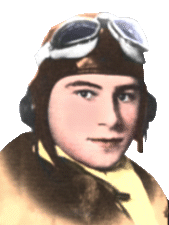 It was at Langley that Joe Sarnoski and Jay Zeamer first met and had occasional contact. In a 1943 letter to Joe’s sister Agnes, Zeamer recalled: “I knew Joe at Langley Field. I remembered how Joe used to fly as a bombardier on the lead ship for exhibitions the Second Group used to put on for the brass hats from Washington (DC) when they came down to Langley.”
It was at Langley that Joe Sarnoski and Jay Zeamer first met and had occasional contact. In a 1943 letter to Joe’s sister Agnes, Zeamer recalled: “I knew Joe at Langley Field. I remembered how Joe used to fly as a bombardier on the lead ship for exhibitions the Second Group used to put on for the brass hats from Washington (DC) when they came down to Langley.”
That recollection by Jay Zeamer is perhaps the best indication of just how good Joe Sarnoski was at his job. Those exhibitions were critical to the Air Corp’s efforts to impress the “brass hats” and obtain the funding to build an air force. Only the best bombardiers would have been selected for the effort, and since the lead bombardier would have the most crucial role, only the best of the best would have been given that assignment.
While stationed at Langley Joe fell in love with a young lady named Marie, and the two were married soon thereafter. He was promoted to Staff Sergeant early in 1941 and continued to fly exhibitions. In one letter home Joe included a photo of his B-17 and wrote on the back of it: “I remember when this picture was taken very well for right after we dropped our bombs, I picked up the paper and saw where Hitler said he wasn’t afraid of the U.S. So, I started to whistle, ‘I’ll be glad when your dead you rascal you.’ Ha! Ha!” Joe was sure he would soon be heading to Europe for combat.
Joe and Jay Zeamer met again in September, just before Joe was transferred to Bangor, Maine, to serve as a bombing instructor. Marie returned to her home in Richmond while he was gone. Then came December 7, 1941, the attack on Pearl Harbor–and everything changed.
Joe’s unit was transferred to Australia on January 13, 1942, and two months later he was promoted to Technical Sergeant. At first, his expert skills were utilized to train others, a role that disappointed him. In a letter to his sister Jennie, he wrote: “My main job here is instructing. But I do hope that I will do some bombing. I would like to sink at least five enemy ships. I have told my squadron commander that if I don’t, I’m going to be ashamed to go back to the States.”
Though Joe did fly some combat missions and earned a promotion to Master Sergeant, it was his reunion with Jay Zeamer that enabled him to achieve his full potential. Jay Zeamer was happy to work with Master Sergeant Sarnoski. He later wrote: “Joe never missed with either a bombsight or a machine gun.”
When Joe Sarnoski and Captain Rocky Stone approached Zeamer to fly with them, when they suggested that he in fact organize their own aircrew, it was exactly what Zeamer had been waiting to hear for months.
“Eager Beavers”
Captain Jay Zeamer didn’t have much to draw from in organizing an aircrew. He couldn’t even promise his men an airplane, but that didn’t deter him. He scoured the squadrons of the 43rd Bomb Group for the men no one else wanted, the cast-offs and screw-ups. In some ways, it might have even seemed comical. Jay Zeamer was the pilot who still had never been checked out to fly in the left seat. Though likable, he was still the guy no one wanted to fly with, and he was gathering around him a crew of men that like himself, were rejected by the other aircrews. Walt Krell recalled, “He (Zeamer) went through the outfit and recruited a crew from a bunch of renegades and screw-offs. They were the worst of the 43rd–men nobody else wanted. But they gravitated toward one another and they made a hell of a crew.”
To make matters even more comical, Jay’s misfit crew didn’t have an airplane. There again, Zeamer had his own ideas. One day an old B-17E with the tail number 41-2666 was flown in and parked on the airstrip. The bomber had seen better days and its frame bore evidence of its heavy record of aerial combat. It was so badly shot up it was now worthless and was parked at the end of the runway where other aircrews could cannibalize it for needed parts. Captain Zeamer quickly intervened and claimed it as his own.
Zeamer’s crew went to work on what would normally have been an impossible task–turning #41-2666 into a combat-ready bomber. They cleaned it up, patched the holes, fixed its engines, and modified it to their liking. Jay had a 50-caliber machine gun mounted in the nose so he could fire from the cockpit like a fighter pilot. In the nose, the 30-caliber flexible guns normally manned by the bombardier and navigator were replaced with swivel-mounted 50-caliber machine guns. The waist guns and radioman’s guns were replaced with twin-50s, giving the airship unprecedented firepower.
Zeamer’s crew put guns where they didn’t even need guns, leaving loose machine guns on the catwalk so that if a gun jammed at a critical moment, they could dump it and quickly replace it with a spare. Sergeant George Kendrick even mounted a gun behind the ball turret near the waist. “I don’t know who would have handled that except the side gunner” Jay recalls. “He wanted all the guns he could get! He wouldn’t let another gunner back there with him. He said, ‘These are my guns. I’m going to shoot them all. I don’t want to be bumping asses with another guy back here!’ This was George Kendrick, the screwball of the crew.”
In truth, in the eyes of the other pilots and ground crews at Port Moresby, the entire crew was screwballs. That impression aside, however, it quickly became apparent that the men were building a flyable, fightable, bomber. At a time when aircraft and spare parts were in short supply, quickly other pilots and ground crews began eyeing #41-2666 enviously.
Walt Krell recalled what happened when it came to a head. “Jay was so mad…he ordered his men not to give up the airplane and they weren’t about to see that happen. By now they would have done anything for Zeamer. They loaded their fifty calibers and they told everyone to stay the hell away, and Zeamer and his crew even slept in that damn airplane for fear someone would try to take it away from them…Everyone was talking about him and his renegades.”
In the months of missions that followed Jay’s crew was so busy that they never had the time to adorn their bomber with the traditional nose-art, commonly seen on aircraft of that era. Though many subsequent accounts refer to Jay’s bomber as Lucy, that was a title Zeamer and crew denied and avoided reference to even in later interviews. The only markings the converted B-17E bore was the tail number. She became known simply as Old 666. Whenever there was a mission–any mission, no matter how dangerous–Jay Zeamer and his crew were the first to volunteer. They hung around the operations center just waiting for a mission. Soon they too earned a nickname…
They were called the:
Eager Beavers
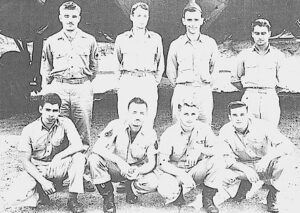
Battle of The Bismarck Sea
 If the men of the Fifth Air Force had failed to understand that the Pacific war was supposed to be just a containment action, they were not alone. Since August 7, 1942, landing at Guadalcanal, General Alexander Vandegrift’s Marines had fought like they were planning to defeat the Japanese…and they did. By December the struggle for the southernmost of the Solomon Islands was nearing its end and the battle-weary Marines were relieved by infantrymen from U.S. Army. The Tokyo Express made its last run to reinforce the region on November 30. The Marine Corps’ Cactus Air Force at Henderson Field on Guadalcanal now numbered more than 150 fighter aircraft and ruled the skies.
If the men of the Fifth Air Force had failed to understand that the Pacific war was supposed to be just a containment action, they were not alone. Since August 7, 1942, landing at Guadalcanal, General Alexander Vandegrift’s Marines had fought like they were planning to defeat the Japanese…and they did. By December the struggle for the southernmost of the Solomon Islands was nearing its end and the battle-weary Marines were relieved by infantrymen from U.S. Army. The Tokyo Express made its last run to reinforce the region on November 30. The Marine Corps’ Cactus Air Force at Henderson Field on Guadalcanal now numbered more than 150 fighter aircraft and ruled the skies.
In New Guinea, the Allies had established airfields on the northern coast of the Papuan Peninsula. Throughout November and December, pilots of the Fifth Air Force turned back at least six major attempts by the Japanese to reinforce Buna by sea. Meanwhile, American infantrymen under General Robert Eichelberger fought their way over the Owen Stanley Range. By the first week of January 1943, both Buna and Gona were under Allied control.
General MacArthur knew that the Japanese were stinging from their long list of defeats in the region, and were desperate to turn the tide of the war. He predicted that they would respond by trying to reinforce Lae early in the new year by dispatching a massive convoy out of Rabaul under cover of the first really bad weather. He advised General Kenney to watch for the next front of heavy weather and to have his pilots maintain constant reconnaissance.
A major storm front moved through the area in the last days of February. On the afternoon of March 1, one of Kenney’s B-24 Liberators found fourteen enemy ships moving south towards New Guinea through the Bismarck Sea. MacArthur’s predicted new Japanese offensive was indeed underway.
Japanese records later indicated that eight troop transports, escorted by eight destroyers, departed Rabaul on February 28. They were carrying nearly 7,000 troops of the 51st Division to reinforce Lei and Salamaua. After they were sighted on March 1, American and Australian pilots began hammering the Japanese, both at sea and at Lei, to keep the aerodrome from getting its aircraft into the fray.
Over the next three days, the bombers provided the ultimate proof of what Billy Mitchell had tried to demonstrate decades earlier when he pitted his bombers against a captured German battleship off the east coast of the United States. Thanks in large part to the new concept of skip-bombing, the Japanese force was decimated in two days of combat. Four of the enemy destroyers and all eight troop transports were sunk by Fifth Air Force and RAAF bombers. Of the 7,000 soldiers of the 51st Division, fewer than 800 reached and landed at Lei. Japanese records later acknowledged that 3,664 men were either killed when their transports sank or were lost at sea. Fewer than 2,500 survivors were rescued and taken back to Rabaul. Losses for the Allies were but a single B-17.
The smashing victory in the Bismarck Sea opened the way for MacArthur to begin implementing a military campaign he had long considered; one he had dubbed Operation Cartwheel. The strategy was elementary to his plan for an island-hopping return to liberate the Philippines. In the early stages of designing Operation Cartwheel, the key objective was the capture of Rabaul.
On April 15 General MacArthur and Admiral William F. Halsey met in Brisbane, Australia, to coordinate their respective offensives designed to take Rabaul. Initially, MacArthur had commanded only the Allied Forces in the Southwest Pacific from Australia to New Guinea, while Halsey commanded the South Pacific which stretched from the Solomon Islands to Pearl Harbor. When Guadalcanal fell, all of Halsey’s future objectives lay in the Southwest Pacific area under MacArthur’s command. Fortunately, Halsey was a rare breed of a naval commander who let his intelligence over-ride any ego or inter-service rivalry. Following his meeting with MacArthur he stated, “Five minutes after I reported, I felt as if we were lifelong friends.”
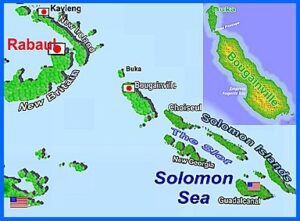 The strategy for the capture of Rabaul that was worked out in mid-April was a two-pronged assault. MacArthur planned to land his forces on the southern coast of New Britain island to fight their way north to Rabaul. Meanwhile, the Marines under Halsey would begin a march through the Solomon chain, beginning at New Georgia Island and working their way to the heavily fortified Japanese stronghold at Bougainville. The key to the capture of Rabaul, at that point in the planning, was for the Allies to take Bougainville. (Ultimately MacArthur wound up by simply isolating and bypassing Rabaul in his subsequent return to the Philippines.)
The strategy for the capture of Rabaul that was worked out in mid-April was a two-pronged assault. MacArthur planned to land his forces on the southern coast of New Britain island to fight their way north to Rabaul. Meanwhile, the Marines under Halsey would begin a march through the Solomon chain, beginning at New Georgia Island and working their way to the heavily fortified Japanese stronghold at Bougainville. The key to the capture of Rabaul, at that point in the planning, was for the Allies to take Bougainville. (Ultimately MacArthur wound up by simply isolating and bypassing Rabaul in his subsequent return to the Philippines.)
The full implementation of Operation Cartwheel was delayed primarily by a lack of intelligence. MacArthur and Halsey were certain that, following the horrible defeat in the Bismarck Sea, the Japanese would quickly move to reinforce New Britain and Bougainville. Before the next steps in Operation Cartwheel could commence, they would need to obtain important intelligence on the Japanese movements.
In the meantime, the Fifth Air Force continued its regular run of bombing missions against the Japanese, and many of these were flown by Captain Jay Zeamer and his Eager Beavers. In May Zeamer and crew made a skip-bombing run on a Japanese aircraft carrier, swooping within fifty feet of its decks. A few days later on a daylight bombing raid over Rabaul, Old 666 came in so low it was brushing the roofs of the housetops. It seemed that the Eager Beavers were fearless. Everyone in the 43rd Bombardment Group was talking about them, and now in some very respectful tones.
“Whenever the 43rd got a real lousy mission–the worst possible mission of all that nobody else wanted to fly–they went down to see Jay Zeamer and his gang,” said Walt Krell. “They couldn’t keep them on the ground, no matter how bad or rough that mission might be. They didn’t care. They crawled into that airplane and just flew and what was more they always carried out their missions. It was the damnedest thing. They’d fly in the worst possible weather, the kind of storm that made other pilots grateful they were on the ground.
“And Zeamer would always find his way in. Sometimes the weather would be so bad, in ships that were shot up, other planes would crash, or the crews would bail out because it was impossible to get back down safely. Impossible for everyone except Jay Zeamer, that is.”
One of Zeamer’s missions over Rabaul was a psyops flight during which pamphlets were to be dropped. Approaching the enemy stronghold Zeamer told his crew, “Don’t throw them out. I’ll go down low enough so you can pass them out individually, but no lally-gagging around those geisha girls.”
On a night mission over Wewak, the Japanese gunners on the ground managed to fix the flight of incoming American bombers in the glare of several large searchlights. Zeamer got mad and made good use of his specially designed nose gun. In an incredible display of courage and airmanship, he dove on the positions, shooting out three of them and damaging two others. His actions enabled the squadron to complete its mission and get back safely. That action earned the renegade pilot an oak leaf cluster to his Silver Star.
Zeamer’s daring and skill gave his crew great confidence. They believed they could fly anywhere, accomplish any mission. They were convinced that no matter what their condition, Captain Zeamer would always get them home. On a May 5 mission over Madang Old 666 was hit more than sixty times by anti-aircraft fire, the stabilizer was shot out and the oxygen tanks exploded. Validating his crew’s confidence, Zeamer somehow managed to get everyone back safely despite the extreme combat damage. Soon the Flying Fortress was patched up and ready to fly its next mission.
Captain Zeamer was equally loyal to his crew. All of them had been decorated again and again for their heroics. Both Sergeants Vaughn and Pugh had been awarded Silver Stars, and Sergeants Able and Kendrick had each been awarded the Silver Star and the Distinguished Flying Cross. Master Sergeant Joseph Sarnoski had been awarded the Silver Star and Air Medal, but in Sarnoski’s case, it wasn’t enough to satisfy Jay Zeamer. He was instrumental in seeking promotion for his enlisted bombardier and, thanks to Jay’s efforts, on May 24 Joe Sarnoski became a second lieutenant.
Meanwhile, two things were still quite certain:
• General MacArthur was chaffing to begin his assault on Rabaul via New Guinea and Bougainville, and,
• the Japanese were moving quickly to reinforce the region.
For months the weather had prevented any aircrew from flying the photo/recon mission necessary to initiate Operation Cartwheel. No one knew how many enemy troops were dug in at Bougainville, or how many enemy aircraft had been rushed in to reinforce the island. Furthermore, the treacherous coastline with its reefs and hazards needed to be mapped for the amphibious landing. This was the mission that no one seemed to be able to accomplish. It was, indeed, the mission no one wanted. It was so dangerous that no crew could be ordered to fly it, any attempt would have to be made by volunteers. It was, recalled Walt Krell:
“a reconnaissance mission that nobody wanted to take. Nobody in his right mind, maybe. So, they went to see Jay Zeamer and his crew….”
The Mapping Mission
The reconnaissance mission over Bougainville was simple in its concept:
• Depart Port Moresby under cover of darkness.
• Fly over 600 miles of the open sea.
• Arrive at the north end of the island shortly after dawn when there would be enough light to take photographs.
• Slowly cruise southeast at an altitude of 25,000 feet while the camera clicked in the belly of the aircraft to record the terrain below.
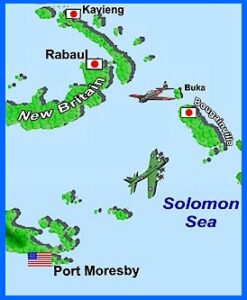 Simple in concept perhaps, but the devil was in the details. Despite Allied air superiority over New Guinea and at Guadalcanal, Japan ruled the seas and the airspace from New Britain to Choiseul. A lone photo-recon aircraft might find itself hopelessly outnumbered and, for the mission to succeed not only did the photographs have to be taken, but the airplane carrying that camera had to be able to get that film safely home.
Simple in concept perhaps, but the devil was in the details. Despite Allied air superiority over New Guinea and at Guadalcanal, Japan ruled the seas and the airspace from New Britain to Choiseul. A lone photo-recon aircraft might find itself hopelessly outnumbered and, for the mission to succeed not only did the photographs have to be taken, but the airplane carrying that camera had to be able to get that film safely home.
“That job had been hanging for months, and nobody else had been able to do it,” Captain Zeamer wrote in a letter five months after the mission. “We just put extra guns all over our ship hoping to be able to fight our way clear. We had 19 machineguns which are more than any other Flying Fortress in the Southwest Pacific has ever thought of having.”
On June 15 the ground crew of Abel, Vaughn, Pugh, and Kendrick prepared Old 666 for its important mission of the following day. Two of Captain Zeamer’s officers were grounded by malaria so 2nd Lieutenant John T. Britton became the volunteer co-pilot and 2nd Lieutenant Ruby Johnston the volunteer navigator.
Eager Beaver bombardier Joe Sarnoski could have…indeed by all standards should have…been excused from the mission. The young 2nd lieutenant had spent nearly 18 months in the combat theater and had flown dozens of missions and earned both the Silver Star and Air Medal. More recently he had been ordered home to instruct new bombardier recruits. His bags were all packed; his departure was to be effective three days hence–June 19.
Why Joe Sarnoski volunteered for the June 16 mission is anyone’s guess. Since it wasn’t a bombing run his skills as a bombardier were not essential to the mission’s success. Perhaps he wanted one last mission before going home. Maybe he sensed that in the face of intense danger Old 666 should have its vulnerable nose protected by the gunner who knew it best. More likely, however, Joe just couldn’t imagine the men who had been his brothers through so many harrowing missions in the past, undertaking so dangerous a mission without him.
By the time darkness fell over Port Moresby on June 15 Old 666 was armed to the teeth and ready for action. While the crew headed for their cots to get a good night’s rest before their 4 a.m. takeoff, Captain Zeamer was given an additional last-minute order. While in the air over the coastline of Bougainville, he was instructed to fly over the smaller island of Buka which was separated by a thin waterway known as the Buka Passage. There he was to make a reconnaissance of the Japanese airfield there to determine logistics and enemy strength.
This new assignment changed the mission from being one of immense danger to one of sheer suicide. Captain Zeamer was furious. His mission was to photograph Bougainville and then get the images back home. A side trip over Buka would almost surely doom his airplane and crew, making the entire mission a futile waste. As he turned in for the night Zeamer had already made up his mind that he would photograph Bougainville, but he would not risk his men or his B-17 over Buka.
Old 666 lifted off from Port Moresby right on schedule at 4 a.m. In the clear Plexiglas nose, Lieutenant Johnson plotted a course over 600 miles of open waters of the Solomon Sea. Nearby, Joe Sarnoski checked and double-checked the vertical camera switches he would activate when the time came for Sergeant Kendrick to begin his all-important work of taking pictures from further back in the belly of the Flying Fortress.
For three hours Old 666’s four, big engines churned the air as Jay Zeamer flew into the rising sun and one of Japan’s most fortified islands. Shortly before 0700, the faint dawn revealed the distant outline of Bougainville Island. The B-17 was thirty minutes ahead of schedule. The sun had not yet risen high enough to illuminate the island’s west coast sufficiently for photographic purposes.
“Aw, hell….” Zeamer thought as he considered his early arrival and pondered the suicidal last-minute order he had previously determined to ignore. “Navigator, plot a course for Buka,” he announced.
Minutes later a thin slip of water passed 25,000 feet below the Fortress, and then the dense jungle of Buka appeared in the lens of Kendrick’s camera. Carved in the foliage below was a honeycomb of small airplane revetments, all leading to a massive airstrip. With a sinking feeling, Captain Zeamer suddenly realized why headquarters wanted this recon–more than 400 enemy fighters had been flown into the Buka aerodrome the previous day.
In the belly of Old 666, Sergeant Kendrick snapped a photograph while noting the time in his camera log. It was 0700. Later that photograph would reveal twenty-one enemy fighters either warming up or taking off to interdict the American bomber.
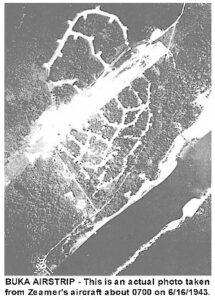 “The thing we should have done then was high-tail it for home,” Zeamer later stated. But even as Sergeant Forrest Dillman announced over the interphone from behind his guns in the ball turret that he could see enemy fighters taking off, Captain Zeamer turned southeast to level off and begin his photo/mapping mission of Bougainville’s west coast.
“The thing we should have done then was high-tail it for home,” Zeamer later stated. But even as Sergeant Forrest Dillman announced over the interphone from behind his guns in the ball turret that he could see enemy fighters taking off, Captain Zeamer turned southeast to level off and begin his photo/mapping mission of Bougainville’s west coast.
“The mapping had to be done that day,” Zeamer explained years later. With the invasion of Bougainville already being planned, those photographs would mean life or death to thousands of young American Marines. “They had to know where the coral reefs were. A landing craft getting caught in a coral reef would result in the men getting blown out of the water before they could get overboard. So, it was most important for us to get the photographs from which charts could be made.”
While his dedicated crew stood by their guns and scanned the sky for trouble, Captain Zeamer held his Flying Fortress steady at 25,000 feet. Old 666 cruised evenly on a straight and level course over Bougainville while the camera clicked steadily.
Survival is Impossible
Prop-wash kicked up a cloud of dust on the earthen runway at Buka as Chief Flight Petty Officer Yoshio Ooki throttled the engine of his A6M Zero. In the distance the American Flying Fortress that had dared to make a lone incursion over Buka was fading slowly, to become little more than a speck in the clear dawn of the morning. Ooki gave a thumbs-up and then his fighter was taxiing for takeoff. Behind him roared the engines of seven additional Zeroes, the remainder of the Japanese commander’s battle-tested squadron.
The 251st Kokutai was part of the recently arrived reinforcement of 400 aircraft at Buka, following distinguished service nearer the Japanese home islands. The cracker-jack outfit was part of the massive air power shift to the Solomons in the Empire’s desperate attempt to turn back the sweeping air superiority gained by General Kenney’s 5th Air Force. Ooki’s pilots were veterans, skilled fighters, and able tacticians who were determined to surprise the American pilots with their aerial prowess. On this day Yoshio Ooki had no doubt that if he and his men could catch up to the fading B-17, they would send it down in flames.
It was slow work, climbing for altitude and racing to catch the enemy bomber, but Ooki and his squadron nursed every ounce of speed out of their engines. The race was too much for Shunichi Yahiro’s fighter, and while still in pursuit the Japanese pilot’s engine gave out and sent him crashing into the sea. Yahiro survived and was later rescued, but at that moment Ooki’s only thought was for the B-17 in the distance. The American Flying Fortresses were known to be heavily armed and had successfully fought off five, six, and occasionally even more fighters. But the numbers today were certainly against the Americans. To increase the odds, Ooki’s remaining seven Zeroes were joined in the air by at least two twin-engine Dinah’s. Ooki knew also that the other airfields on Bougainville would quickly field more Zeroes, should they be needed.
The morning sun was creeping over the island and bringing with it a light cloud cover, but as he raced southward Ooki couldn’t believe his luck. The pilot of the American bomber was making it too easy. The big airplane didn’t break and run for the clouds–didn’t dive and head out to sea. Instead, the pilot continued on a straight and level heading. It was as if the enemy pilot was begging to be attacked and destroyed.
Captain Zeamer was indeed making it easy for the enemy fighters. “The mapping had to be extremely accurate and you don’t dare dip the wing a degree or the focal point on the ground moves over a mile,” he recalled in one interview. At 0740 Zeamer had only 22 minutes of flight time remaining to complete his mission.
In the distance, the crew could make out the shapes of at least fifteen Zeroes and two Dinahs. No one would have faulted the crew had they then opted to turn and run for home. Zeamer’s Eager Beavers knew, however, that for the first time in months the important photos of Bougainville were being recorded on film. These were pictures that could save thousands of American lives.
In the tail of the heavily armed Fortress, Sergeant Pudgy Pugh unleashed a torrent of 50-caliber rounds at the pursuing enemy. Technical Sergeant Forrest Dillman swiveled his ball turret to add his own firepower. The deadly fusillade momentarily stunted the advance and bought precious time.
 In the belly of Old 666, Sergeant Kendrick kept his camera rolling. In the clear Plexiglas nose, Lieutenant Sarnoski stood ready at his guns, scanning the sky ahead for any sign of enemy fighters that might try to attack from the front.
In the belly of Old 666, Sergeant Kendrick kept his camera rolling. In the clear Plexiglas nose, Lieutenant Sarnoski stood ready at his guns, scanning the sky ahead for any sign of enemy fighters that might try to attack from the front.
In the cockpit Captain Zeamer held his course while the co-pilot and navigator called out numbers, helping him to keep the wings level, the airspeed constant, and the bomber’s altitude consistent at 25,000 feet.
In the distance, Jay could make out the wide opening at the middle of the Bougainville Island. That would be Empress Augusta Bay, he knew. If he and his crew could hold on for just another twenty minutes their mapping mission would be completed. The respite bought by the aggressive and accurate fire of Pugh and Dillman might prove to be just enough.
The hail of 50-caliber machine gun fire that swept past Yoshio Ooki’s canopy did little to dissuade his determined assault on the lone Flying Fortress. Leading his squadron into the battle, Ooki winged over to sweep wide around the bomber. The American pilot gave no indication of diverting from his suicidal course, so the Japanese squadron chose to take advantage of the situation by getting in front of him and attacking the bomber’s most vulnerable position–the nose.
The maneuver took more than fifteen minutes, the Zeroes speeding off to the side and then circling to get in front of the B-17. By the time the Fortress was over Empress Augusta Bay, Ooki and five of his fighters were well in front and turning for an all-out attack on the nose and cockpit. Ooki’s seasoned pilots were spread out neatly from left to right in the 8 o’clock, 10 o’clock, 12 o’clock, 2 o’clock, and 4 o’clock positions. It was a semi-circle of certain death. When Ooki gave the command to attack, all five Zeroes would come in with 20mm cannon and 7.7mm machine guns firing.
The two opposing forces were on a collision course at a combined speed of more than five hundred miles per hour. Still, the pilot of the American bomber stayed straight and level–almost as if oblivious to the presence of impending doom.
Captain Zeamer was far from oblivious of the enemy’s presence, however. He knew he was in trouble, and worse, he knew he was up against a formidable foe. In nearly a year of combat that included 47 aerial missions, Captain Zeamer had never seen more than two Japanese fighters in a coordinated frontal attack. Such tactics required timing, practice, and precision. Now he faced five fighters in such an arrangement. Jay knew these enemy pilots were good–very good!
As Ooki’s squadron dove in with guns blistering the sky, Zeamer was less than a minute from completing his mission. He also knew the enemy would be on top of him in far less time than that. “The dumbest thing you can do with a B-17 when you’re under attack against fighters is to hold it straight and level,” Jay recalled. “Everyone I know who did that (against two fighters) got shot down. But here are five coming in five different directions. I thought, ‘My gosh if I maneuver against one, I’ll make myself a better game to the others.’ That, coupled with the fact that the mapping was important, I kept going straight.”
The two forces met over Empress Augusta Bay at 0800. Yoshio Ooki dove his Zero towards the cockpit of the American bomber and unleashed his 20mm cannon. Breaking off less than 50 feet from the point of collision, the two pilots might well have seen the surprise, each on the face of each other. While holding his bomber on course, Zeamer had unleashed a string of 50-caliber rounds from his own specially mounted nose gun, raking Ooki’s Zero and sending him plummeting earthward with fuel streaming from his wing tanks.
Old 666 shook with the force of fire from all its nose guns, then trembled as Ooki’s 20mm destroyed the cockpit. Simultaneously, Lieutenant Sarnoski fired at the Zero to the left (at the 10 o’clock position.) It erupted in front of the nose from the bombardier’s accurate fire, but not before one of its own 20mm cannons shattered the Plexiglas of the American bomber. Sarnoski was thrown backward, beneath the catwalk. His body was shredded with shrapnel and broken glass. A deadly gash in his side had nearly split him in half.
In the cockpit, Captain Zeamer could see what was happening below. The enemy cannon had ripped huge holes in the floor of the cockpit and peppered his own legs and feet with small pieces of shrapnel. Air screamed in through the holes in the floor, and Zeamer watched as Lieutenant Johnston rush to the mortally wounded bombardier to try to stem the flow of blood from a neck wound. Joe Sarnoski shook him off. “I’m alright,” he struggled to announce. “Don’t worry about me.” More enemy fighters were now firing on the bomber’s shattered nose, and every gun was needed in those critical moments.
Slowly, painfully, Joe Sarnoski dragged his body across a torn catwalk that was now slick with his own blood. He forced himself upright and from a crouch opened fire on a twin-engine Dinah that was moving in for the kill. Once again Sarnoski’s accurate fire sent an enemy fighter down in flames, but not before more cannon fire hit the cockpit.
More than 100 pieces of sharp metal from this new fusillade tore into Captain Zeamer, shattering his feet and paralyzing his legs. Bullets sprayed the cockpit and tore into the pilot’s arms and legs. “I never felt so much pain in my life,” he recalled. “One of the shells exploded at my feet. It ripped off my rudder pedals, tore gobs of flesh from my legs, and shattered my left knee. Blood from my ruptured wrist was spurting across my lap every time my heart pumped.”
Captain Zeamer and his crew had run out of time. The last explosion had ruptured the bomber’s hydraulic system, destroyed the cockpit flight instruments, and severed control cables. It had also knocked out the oxygen supply and, at 25,000 feet the crew would quickly be rendered unconscious unless Zeamer dove. Despite his agonizing pain, he found the strength to manipulate the controls and bank hard to the right, plummeting to 10,000 feet above the sea.
Falling behind Jay Zeamer’s bomber in his own desperate effort to avoid disaster, Yoshio Ooki fought his own controls to nurse his fighter back to Buka. Pilot Hiroshi Iwano protectively followed his squadron leader in his own undamaged Zero. Three pilots of the 251 Air Squadron had also taken hits from the accurate fire of Zeamer’s besieged bomber (Tadaharu Sakagami, Tadashi Yoneda, and Ichirobei Yamazaki), but Kooichi Terada apparently never got in position to fire around. The eighth Japanese fighter, piloted by Suehiro Yamamoto, had to break off and return home after expending all of his ammunition. In all, 251 Squadron reported firing more than five hundred 20mm and more than seven hundred 7.7mm rounds in their attempt to destroy the Flying Fortress that had dared to venture alone into the heavily defended Bougainville/Buka area.
Yamamoto witnessed the stricken Fortress’ desperate dive just as he banked for home. His after-action report noted: “Enemy aircraft generates smoke and disappeared in the cloud. Later, it was found having crashed in the mountains of Bougainville.”
It was small comfort for the crack Nippon squadron that had lost one fighter in the ocean and suffered four others badly damaged.
Contrary to Yamamoto’s report, Old 666 did not crash into the mountains. Captain Zeamer struggled with the controls to pull his bomber out of its dive and level off at 10,000 feet. Then he pointed her shattered nose westward, towards home 600 miles distant. Fighting off waves of pain Jay struggled to keep his bomber in the air. Meanwhile, at least seventeen enemy fighters from other enemy squadrons dove downward on the withdrawing Flying Fortress to deliver the coup de grace. Sergeant Able flamed one of them with the twin-50s in the top turret but paid for it in pain. Enemy rounds struck him in both legs.
Time and again enemy fighters tried to race ahead of Old 666 for another frontal attack. The nose guns were out of commission from the heavy damage, Lieutenant Johnston was now wounded, and Lieutenant Sarnoski was slumped silently over his own machinegun. He had mercifully slipped into unconsciousness after summoning one last effort of unbelievable strength to turn back the final deadly assault. Fortunately, with the mapping mission done, Captain Zeamer was now able to concentrate on maximum airspeed and evasion. “I just maneuvered the hell out of that airplane for the next forty-five minutes as they (Jap fighters) came in one after the other,” Jay Zeamer recalled.
Lieutenant Britton tried to take control of the floundering B-17 for his badly wounded pilot. Zeamer refused to give up, convinced that the fate of his crew depended upon his own abilities and experience. Unlike a standard bombing mission where, if you were shot down after reaching the target, one still had the satisfaction of mission accomplishment, unless Old 666 got back to New Guinea with its film intact the whole ordeal would have been for naught. “He (Zeamer) was just going at it with a vengeance,” recalled Britton. “I don’t know where he got the strength!”
By 0845 the American bomber was over open seas and the enemy fighters, low on ammunition and fuel, were forced to turn back to Bougainville. Only then did Sergeant Able leave the ball turret. He hobbled up to the cockpit on his two wounded legs. There he found his Zeamer covered in blood and there was a fire in the oxygen system behind his seat. He shouted for Lieutenant Johnston to come to help him, and together the two wounded crewmen beat out the flames.
Sergeant Pugh left his position at the tail gun to check on Lieutenant Sarnoski in the ruptured nose of the aircraft. He found the Eager Beaver’s bombardier still slumped where he had fought valiantly throughout the fray, poised over his gun with his finger on the trigger. Pudgy Pugh lifted him up and pulled him away from the jagged edges of the ruined battle station. Gently he cradled the body of his friend while Old 666 continued its desperate flight home. Halfway there, his head resting in the young gunner’s lap, Joseph Raymond Sarnoski died.
Lieutenant Britton and Sergeant Kendrick turned their attention to their wounded pilot, cutting away clothing to find his multiple wounds and try and stop the bleeding. Throughout the long flight home, the indomitable airman passed in and out of consciousness, but he refused to give up control of his airplane. “I don’t move until the mission is ended,” Zeamer announced.
His determination aside, both of Jay’s legs were paralyzed, both arms were useless, and he was literally controlling Old 666 by his fingertips. Sergeant Vaughn managed to give him a shot of morphine to ease the pain while Sergeant Able took a position in the co-pilot’s seat to fly the bomber home. (Lieutenant Britton, the co-pilot, was occupied with tending the wounded and relaying messages from the radio room to the cockpit.) “Captain Zeamer, although severely wounded and losing blood continuously, remained conscious throughout the trip,” wrote the 19-year old gunner. “Although in great pain he kept his head and kept command of the ship until we landed. I have never seen a man with so much ‘guts’.”
Shortly before noon Sergeant Able saw the northern shoreline of New Guinea in the distance and returned the co-pilot’s position to Lieutenant Britton. Fighting waves of unconsciousness brought on by the loss of blood, Captain Zeamer still directed the return and subsequent landing. Fearful that Old 666 was so badly shot up that it wouldn’t clear the Owen Stanley Range, he ordered Britton to land at Dobadura. Without hydraulics or brakes, the co-pilot managed to bring the ship home, taxiing to a stop at 1215. In only eight-and-a-quarter hours several lives had been changed, one life had been lost–and just perhaps, due to the incredible determination of one B-17 crew, thousands of Marines might be saved.
The rescue crew that welcomed Old 666 to Dobadura that day were astounded by what they saw. The fortress bore the marks of 187 bullet holes, and gaping wounds from five 20mm cannons. While the wounded were helped to the ground and loaded in ambulances, the semi-conscious Zeamer overheard one-man remark:
“Get the pilot last. He’s dead!”
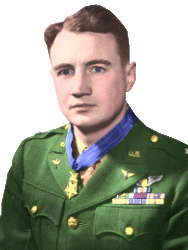 Reports of Captain Zeamer’s death, including a death notification to his parents back in the United States, were premature. More than 120 pieces of ragged steel were picked from his body and three days of blood transfusions were required to keep him alive. During the ordeal, the intrepid pilot had lost 50% of his blood volume and by all best estimates, he should not have survived. His leg was shredded and even after Jay’s prospects for survival improved, time it was feared that his leg would have to be amputated. Only the fact that he had lost so much blood that the surgeons believed he would not survive the amputation prevented that drastic measure.
Reports of Captain Zeamer’s death, including a death notification to his parents back in the United States, were premature. More than 120 pieces of ragged steel were picked from his body and three days of blood transfusions were required to keep him alive. During the ordeal, the intrepid pilot had lost 50% of his blood volume and by all best estimates, he should not have survived. His leg was shredded and even after Jay’s prospects for survival improved, time it was feared that his leg would have to be amputated. Only the fact that he had lost so much blood that the surgeons believed he would not survive the amputation prevented that drastic measure.
Jay’s determination to live was perhaps the only thing more incredible than what he had accomplished in the cockpit of Old 666 on a fateful mission over the Buka Passage. In his own memoirs, Fifth Air Force Commander General George Kenney wrote: “Jay Zeamer and his crew performed a mission that still stands out in my mind as an epic of courage unequaled in the annals of air warfare.”
Raymond Sarnoski died in the arms of Pudgy Pugh on the flight home. His personal determination to remain at his guns during the most critical moments of the mission had made the difference, but he paid for it with his life. Two days after the mission a memorial service was held to remember Lieutenant Raymond Sarnoski, and the bombardier was buried on a knoll near the New Guinea airstrip. Sergeants Able and Vaughn obtained permission to leave the hospital beds where their wounds were being treated in order to attend the ceremony. The four un-injured members of the crew were also present, as were scores of other airmen.
Lieutenant Johnston’s head wound was second in severity only to the wounds suffered by Jay Zeamer. Both men were not only confined to hospitals for major medical attention and neither man was even told that Joe Sarnoski had died for several days. Five months later, while still undergoing treatment at Winter General Hospital in Topeka, Kansas, Jay wrote a letter to Joe’s sister Agnes stating:
“I watched the zero that hit both Joe and myself explode in the air when Joe’s tracers hit it,” he wrote. “A twin-engine fighter followed it in but Joe promptly shot him down too. I could see into the nose compartment through holes that had been shot in my instrument panel. Joe was trying to pull himself back up to his guns then but couldn’t make it anymore. I knew then that he had also been hit but I didn’t know how badly.
“When we landed, I was temporarily blind (from loss of blood) and nobody would tell me that Joe had died until two weeks later when I was evacuated from New Guinea.”
While scores of airmen rushed to give blood to keep Jay Zeamer alive during the first critical 72 hours after the mapping mission, Colonel Meriam C. Cooper was reviewing accounts of the mission. As chief of staff to Major General Ennis C. Whitehead, Colonel Cooper had witnessed many reports of great bravery and determination in two world wars. (As a young officer in World War I, in fact, it had been Cooper that had recommended Frank Luke for the Medal of Honor.) After reading the reports of the mission over Buka Colonel Cooper wrote:
“I consider Captain Zeamer’s feat above and beyond the call of duty, comparable to that of Lieutenant Luke, who stands with Captain (Eddie) Rickenbacker as one of the leading flying officers of exceptional courage and daring during the last World War.”
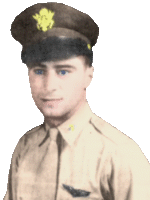 General Kenney promptly endorsed Zeamer’s recommendation for his country’s highest honor. It was presented in a special Pentagon ceremony by General Henry Hap Arnold on January 6, 1944. Thirty days before that presentation the nomination for Lieutenant Sarnoski’s Medal of Honor was also approved. It was presented to his widow Marie at Richland Army Air Force Base on June 7, 1944. (Marie subsequently gave the Medal to Joe’s parents, who in turn granted possession to the Congressional Medal of Honor Society).
General Kenney promptly endorsed Zeamer’s recommendation for his country’s highest honor. It was presented in a special Pentagon ceremony by General Henry Hap Arnold on January 6, 1944. Thirty days before that presentation the nomination for Lieutenant Sarnoski’s Medal of Honor was also approved. It was presented to his widow Marie at Richland Army Air Force Base on June 7, 1944. (Marie subsequently gave the Medal to Joe’s parents, who in turn granted possession to the Congressional Medal of Honor Society).
These presentations marked the first time since World War I and the fateful mission of Lieutenants Harold Goettler and Erwin Bleckley to find The Lost Battalion, that the Medal of Honor was presented to two men from the same airplane. The other seven courageous Eager Beavers were not forgotten in the efforts to recognize the valor of the crew that had accomplished the mission no one else wanted. All seven were awarded the
Distinguished Service Cross, second only to the Medal of Honor. It made the nine men who flew the in Old 666 on that June 16, 1943, mission over Bougainville, perhaps the most highly decorated aircrew in the history of military aviation. (When these nine awards, along with five Purple Hearts are added to the multiple high awards previously awarded members of the Eager Beavers, there is no doubt no other aircraft has ever boasted a more-decorated crew.)
On June 30, just two weeks after the photo/mapping mission of Bougainville, Operation Cartwheel has launched with MacArthur’s infantry landing 60 miles south of Lae and Admiral Halsey’s 43rd Infantry (US Army) landing on New Georgia in the first leg of the march to Bougainville. Six months later US Marines stormed ashore on Bougainville Island. Their landing point was at Empress Augusta Bay, the place where Zeamer and crew had ignored enemy fire until the needed photographs of the landing site could be taken.
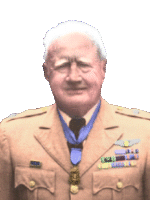 Jay Zeamer spent fifteen months of hospital recovery as a result of his serious, multiple wounds. Following his release from the hospital, he returned to active duty at Mitchell Field in New York as a Field Air Inspector. On January 18, 1945, Zeamer retired on disability as a Lieutenant Colonel.
Jay Zeamer spent fifteen months of hospital recovery as a result of his serious, multiple wounds. Following his release from the hospital, he returned to active duty at Mitchell Field in New York as a Field Air Inspector. On January 18, 1945, Zeamer retired on disability as a Lieutenant Colonel.
 Jay returned to MIT to earn his master’s degree in aeronautical engineering and went on to work for Pratt-Whitney in East Hartford, Connecticut in 1946. In 1949 he fell in love and married, and he and his wife Barbara raised five daughters.
Jay returned to MIT to earn his master’s degree in aeronautical engineering and went on to work for Pratt-Whitney in East Hartford, Connecticut in 1946. In 1949 he fell in love and married, and he and his wife Barbara raised five daughters.
Sixty years after the end of World War II Jay Zeamer, then 82 years old, joined other veterans of the Pacific War for a reunion in Hawaii. There he visited the National Memorial Cemetery of the Pacific (known as the Punchbowl). More than 33,000 of his comrades who never made it home are buried or commemorated there.
Walking slowly among the headstones, Jay stooped forward to rest on his cane and read an inscription. “I didn’t know he was here,” Zeamer said to a nearby Air Force reporter, while the tears of a half-century welled up in his eyes. Indeed, following the end of the war, Captain Zeamer’s valiant bombardier had been re-interred on American soil.
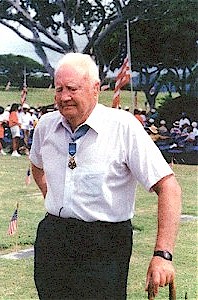
Jay let his cane fall to the green grass, straightened the arch in his back, and presented a long and heartfelt salute to his fallen comrade. Then, with tears still filling his eyes, he forced his war-torn legs to bend so that he could kneel at the grave of Lieutenant Raymond Joseph Sarnoski to arrange a lei of flowers around the headstone.
Lieutenant Colonel Jay Zeamer, USAAF (Retired) passed away on March 21, 2007.
This electronic book is available for free download and printing from www.homeofheroes.com. You may print and distribute in quantity for all non-profit, educational purposes.
Copyright © 2018 by Legal Help for Veterans, PLLC
ALL RIGHTS RESERVED

